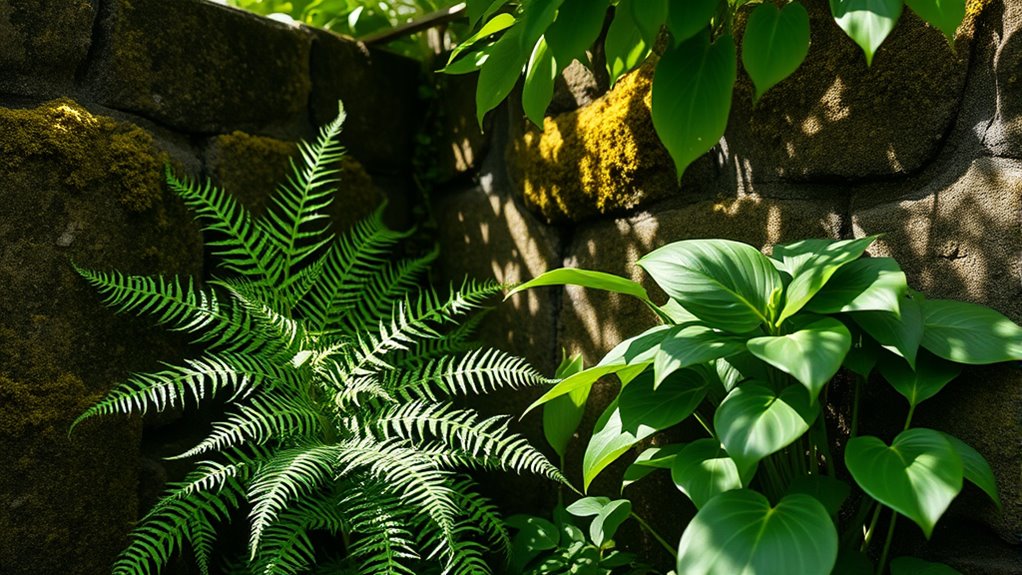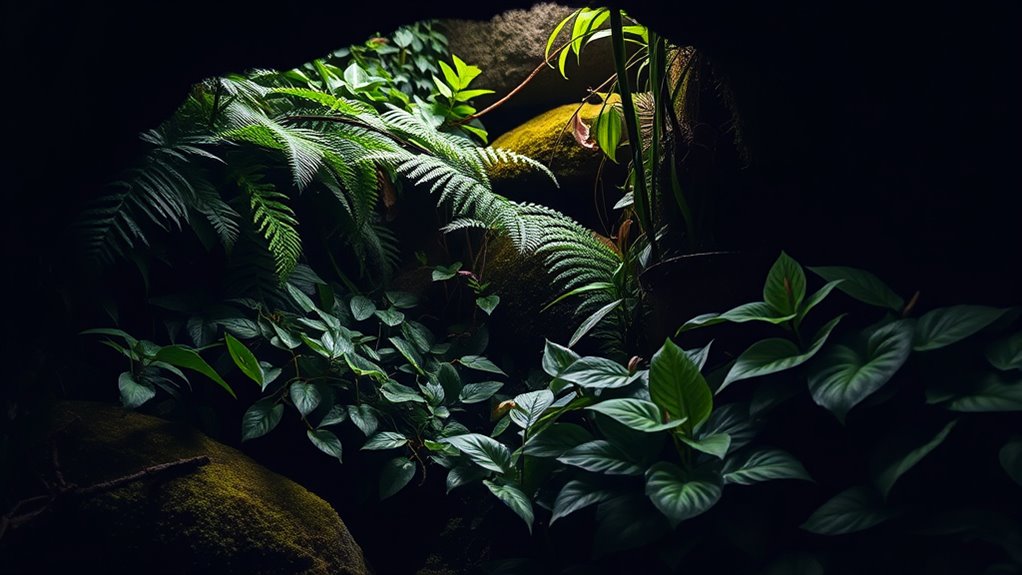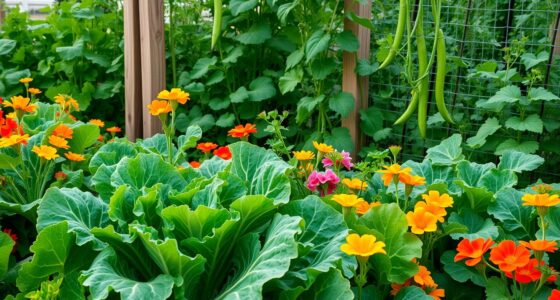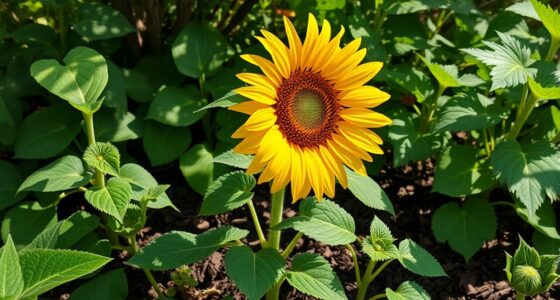To thrive under shade, pair plants like pothos, snake plants, peace lilies, and ferns, which all love low-light conditions. Combine their different textures and forms for visual interest, such as the soft fronds of ferns with the sleek leaves of snake plants. Use reflective surfaces like mirrors or light-colored walls to boost ambient light. For more tips on creating lush, shade-loving plant displays, explore how these strategies work together to transform any space.
Key Takeaways
- Pair plants like Peace Lilies and Ferns to create texture and contrast in shaded environments.
- Use reflective surfaces such as mirrors and light-colored walls to amplify low-light conditions.
- Combine Pothos and Snake Plants for low-maintenance, lush displays that thrive in shade.
- Ensure well-draining soil and proper watering to support healthy growth in low-light settings.
- Incorporate humidity trays or misting to mimic natural conditions and enhance plant vitality.

Finding the right plants for low-light spaces can transform any dull corner into a lush, inviting area. When you’re into indoor gardening, selecting plants that thrive in shaded environments is vital for creating a vibrant atmosphere without much hassle. Low-light plant pairings can bring life to spots that don’t get direct sunlight, making your space feel more welcoming and stylish. To succeed, you need to understand the specific needs of these plants and develop effective plant care tips to keep them healthy.
First, consider combining plants like pothos and snake plants. Pothos is incredibly adaptable and forgiving, making it perfect for shady corners. Its trailing leaves add visual interest, and it can handle infrequent watering. Snake plants, with their upright, architectural leaves, also excel in low-light conditions and require minimal attention. Pairing these two allows you to create a diverse, low-maintenance display that looks lush and well-curated. When you’re doing indoor gardening, it’s essential to remember that even shade-loving plants need proper watering, well-draining soil, and occasional fertilizing. Keep an eye on their leaves for signs of overwatering or underwatering, and adjust your plant care tips accordingly.
Another effective pairing includes peace lilies and ferns. Peace lilies are known for their beautiful white blooms and ability to survive in darker environments. They also help improve indoor air quality, making them practical as well as pretty. Ferns, such as Boston or maidenhair ferns, thrive in moist, shaded conditions, adding a soft, textured contrast to the more upright peace lily. When you’re caring for these plants, guarantee your fern’s soil stays consistently moist, but not soggy, and keep the peace lily’s soil slightly moist as well. Both plants benefit from high humidity, so mist them occasionally or use a humidity tray to mimic their natural environment. Incorporating reflective surfaces like mirrors and light-colored walls is also a proven way to maximize available light and support plant growth in low-light areas.
Finally, don’t overlook the value of using reflective surfaces like mirrors and light-colored walls to maximize available light. Even in low-light spaces, these tricks can boost ambient light levels, supporting your plant’s growth. Remember, successful indoor gardening with low-light plants involves understanding their specific needs and applying simple plant care tips consistently. With the right pairings and proper care, you can turn even the dimmest nooks into thriving green retreats that brighten your home and elevate your space’s aesthetic.
Frequently Asked Questions
How Often Should Low-Light Plants Be Watered?
You might wonder how often you should water your low-light plants. Typically, watering frequency depends on soil moisture—allow the top inch to dry out before watering again. In low-light conditions, plants generally need less frequent watering, usually once every 1-2 weeks. Check soil moisture regularly to prevent overwatering, which can lead to root rot. Adjust watering based on your plant’s specific needs and the environmental humidity.
Can Low-Light Plants Purify Indoor Air Effectively?
You might wonder if low-light plants can really purify indoor air effectively. The good news is that many of these plants, like snake plants and pothos, contribute to improved indoor air quality through plant air purification. While they may not eliminate all pollutants, they can reduce toxins and boost air freshness, making your indoor space healthier. Incorporate these plants to naturally enhance your home’s air quality.
What Are Common Pests for Shade-Loving Plants?
Ever wondered what pests might threaten your shade-loving plants? You should stay alert for common pests like spider mites, aphids, and scale insects. Pest identification becomes essential here—spot the tiny pests early to prevent a full-blown infestation. Using natural pest control methods can help you keep these pests at bay without harsh chemicals. Keep a close eye, and act swiftly to protect your plants’ health and beauty.
How Do I Prevent Low-Light Plants From Leggy Growth?
To prevent your low-light plants from leggy growth, you should regularly perform plant pruning to remove excess leggy stems and encourage bushier growth. Additionally, consider light supplementation by using grow lights or placing plants closer to natural light sources. These steps help your plants develop a fuller, healthier appearance, ensuring they stay vibrant even in low-light conditions. Consistent care makes a noticeable difference in their overall growth.
Are There Any Low-Light Plants Suitable for Outdoor Shaded Areas?
Think of your outdoor shaded area as a hidden gem, perfect for shade-tolerant ferns and evergreen groundcovers. These plants thrive in low light, much like a cozy nook that invites quiet relaxation. I’ve seen shaded gardens flourish with these options, providing year-round greenery. Yes, they’re suitable for outdoor spaces—just choose varieties adapted to your climate, and you’ll create a lush, inviting retreat beneath the canopy.
Conclusion
Now that you know these low-light plant pairings, your space will transform into a lush, vibrant oasis—almost like a secret garden no one else can find! With a little care and clever combinations, you’ll turn even the dimmest corners into stunning green retreats. Think of your plants as tiny miracles, thriving where most would give up. So go ahead, embrace the challenge, and watch your indoor jungle flourish beyond your wildest dreams!









